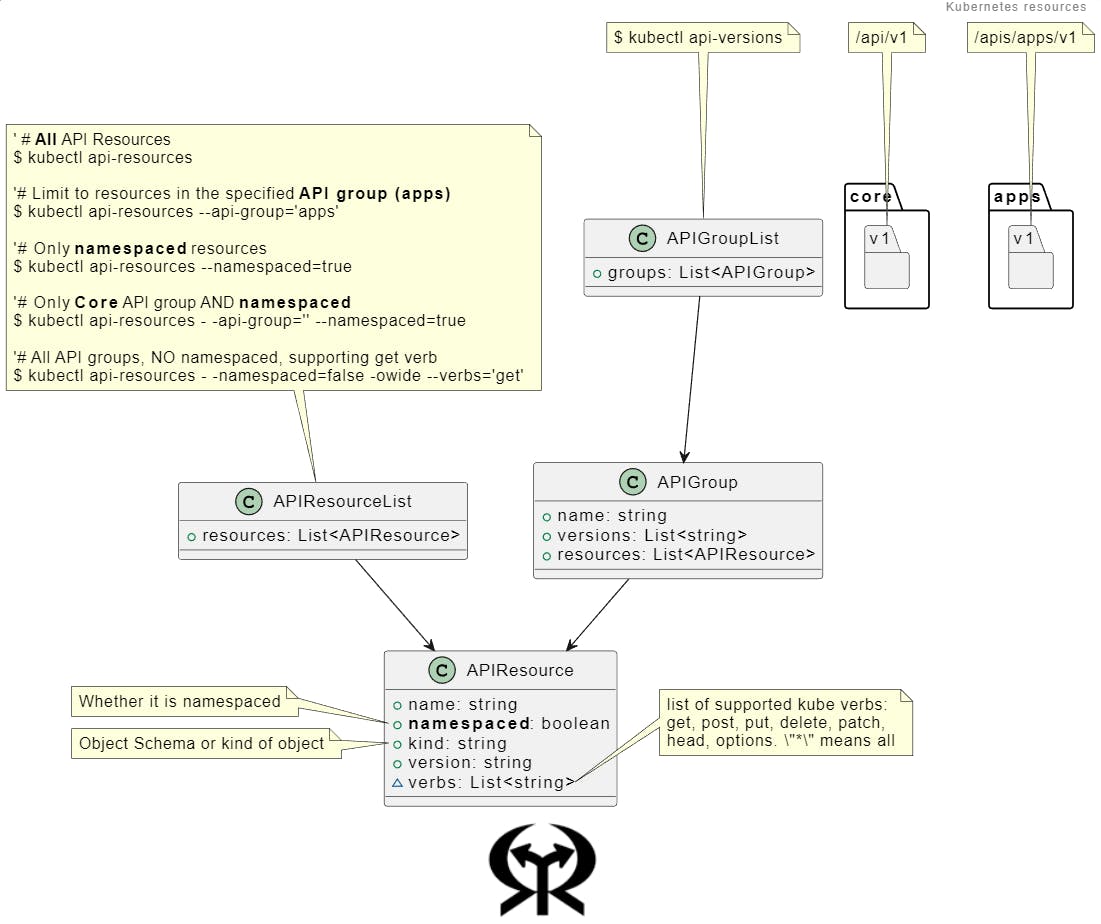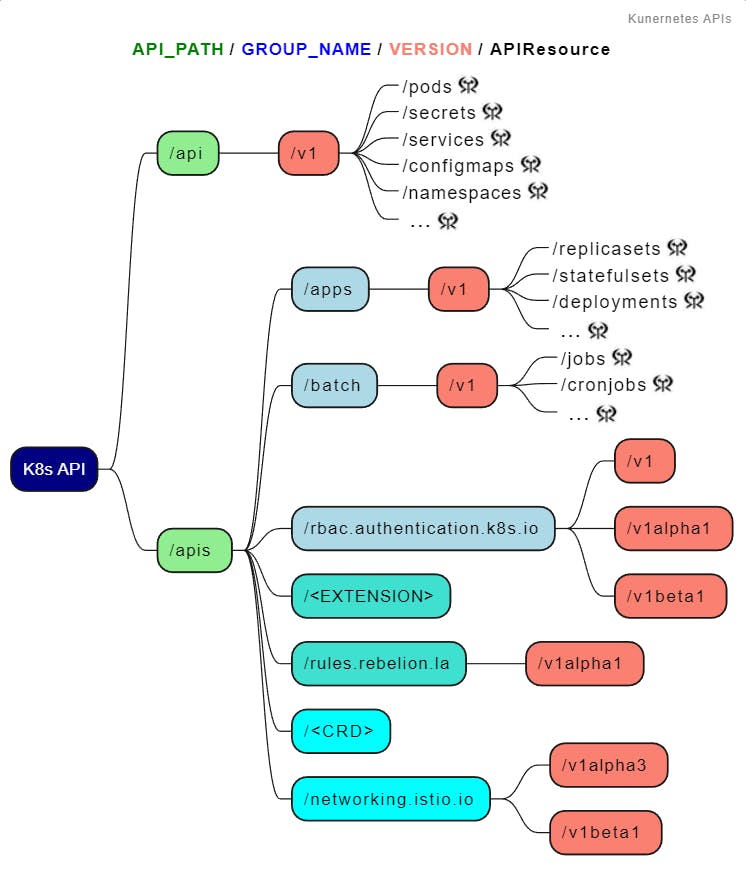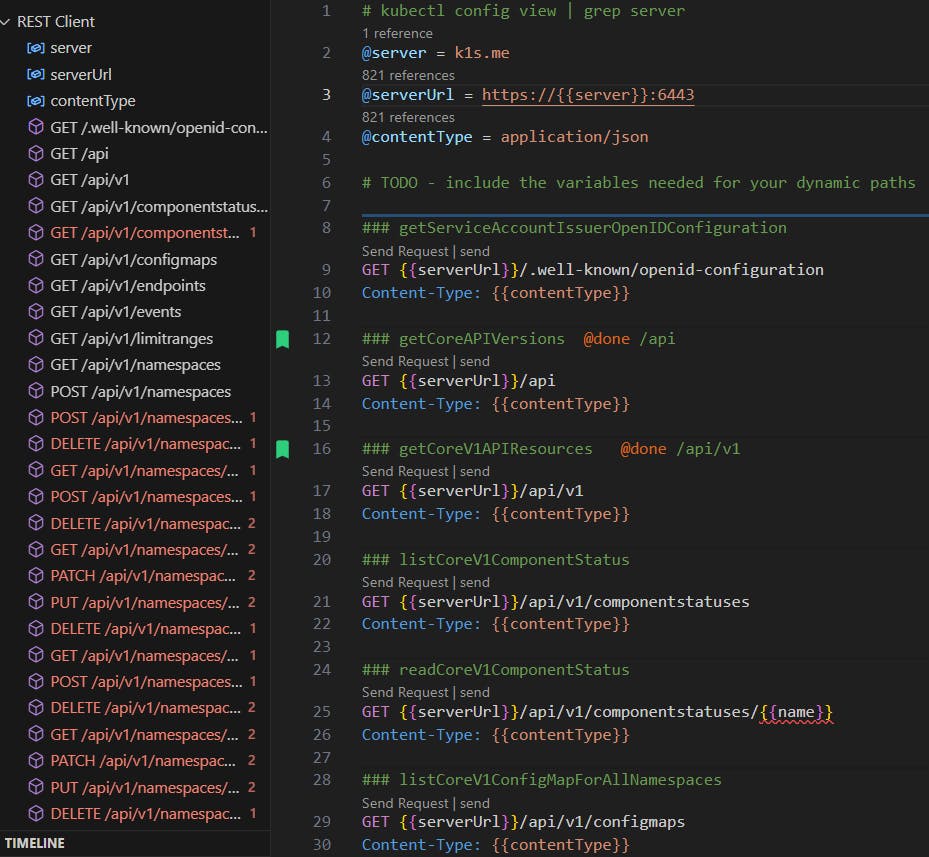Demystifying the Untapped Magic of Kubernetes APIs
Unleashing Kubernetes APIs Full Potential Understanding how resources are composed
Welcome to the exciting world of Kubernetes APIs! If you've ever dived into the Kubernetes universe, you know that API objects are at the heart of everything. But fear not, fellow explorer, I am here to demystify the intricacies of Kubernetes APIs and help you harness their full potential.
Now, imagine a world where you can manage configurations in a declarative way, and interact with the Kubernetes API using tools like kubectl, curl, or even your trusty Postman, Insomnia, or the Swagger Editor. Ah, the possibilities! But before we embark on this adventure, let's unravel the secrets of the Kubernetes API together.
The Swagger Dance: OpenAPI Specs and Their Role
One tool stands out as a guiding light in the vast realm of API-first architectures API-first architectures —the OpenAPI Specification (OAS). Picture this: a standardized way to describe and document APIs, bringing clarity, collaboration, and a touch of swagger to the development process. It's like having a dance partner who knows all the right moves!
With OAS, API providers and consumers can waltz together in perfect harmony. They can clearly understand the API's capabilities, endpoints, parameters, and responses, ensuring a smooth and synchronized dance routine. Just check out the Kubernetes Swagger Specs (version 1.27) —it's like watching an API salsa! 💃🏽🕺🏽
Kubernetes Object Schemas
One important part of the OAS is the Schemas: Schemas define the structure and data types of the input and output objects used in API operations. They specify the properties and their types, allowing developers to understand how to interact with the API and validate data.

Kubernetes Paths
Another important piece is the Paths: This is the heart 💓 of the OAS document. It defines the available endpoints (URLs) of the API and the HTTP methods (GET, POST, PUT, DELETE, etc.) that can be used to interact with those endpoints. Each path is associated with a set of operations. By the time this post was written, we had 428 API endpoints (paths), 113 for the /api group, and 310 for /apis group endpoints! Of course, I am not counting the Custom Resources (CRDs), nor Aggregate APIs.
curl -s "https://raw.githubusercontent.com/kubernetes/kubernetes/release-1.27/api/openapi-spec/swagger.json" | jq ".paths | keys" | grep "\/apis\/" | wc -l

But wait, there's more! OAS brings a plethora of benefits to the API-first party:
Clarity and Consistency: OAS sets the stage for a clear and consistent API design, ensuring everyone is in sync. No more stepping on each other's toes!
Documentation Delight: OAS documents become a lively dance floor, providing comprehensive information about the API's functionalities, parameters, and responses. It's like having a dance instructor guiding your every move.
Collaboration Choreography: With an API contract, developers on both sides can tango confidently. The client knows how to interact with the API, while the server-side sways to the rhythm of the agreed-upon contract.
Tooling Tango: OAS documents let various API-related tools join the dance floor, generating client SDKs, server stubs, and even automated API documentation. It's like having backup dancers, saving you time and effort.
Version Viennese Waltz: OAS gracefully supports API versioning and evolution. It documents changes, ensuring backward compatibility and giving a heads-up about dance floor shake-ups.
The Great API Symphony: Understanding Kubernetes APIs
Now that we've warmed up, it's time to dive into the grand orchestra of Kubernetes APIs. Picture a grand stage with an abundance of resources, each waiting for their moment in the spotlight. And guess what? They're all stored as API objects and modified through RESTful calls to the API.
Let's break it down. Kubernetes APIs are divided into various API groups, each with its unique flair. The core group, also known as the legacy group, struts its stuff at /api/v1. It's the OG, not explicitly specified in the apiVersion field. Just remember, the core API doesn't define the $GROUP_NAME, and it's the only one with the path /api.
But the show doesn't stop there! We have named groups, sashaying their way at /apis/$GROUP_NAME/$VERSION, sporting the trendy apiVersion: $GROUP_NAME/$VERSION. They bring the flavor, showcasing resources like Pods, Services, ConfigMaps, Secrets, and more.

Now, let's take a quick dance break and look at some of the principal performers:
v1: The core API group that houses all the resources at the heart of Kubernetes. It's where all the essential resources reside, such as Pods, Services, ConfigMaps, Secrets, and more. The
v1API group is like the lead dancer, gracefully orchestrating the entire show.apps/v1: This group steals the spotlight with resources like Deployments, StatefulSets, and ReplicaSets. They bring the magic of application management to the stage, allowing you to deploy, scale, and update your applications effortlessly.
batch/v1: Here comes the batch group, showcasing resources like Jobs and CronJobs. They add a touch of timing and scheduling to the dance, allowing you to run batch jobs and automate repetitive tasks.
extensions/v1beta1: Though considered the older sibling of the
apps/v1group, this group still shines with resources like Ingress and ReplicaSets. They offer additional features and capabilities, allowing you to fine-tune your application deployments.
These are just a few of the prominent performers in the grand API symphony of Kubernetes. Each group brings its unique set of resources and functionalities, giving you the power to orchestrate your containerized applications with finesse.
The Choreography of API Interactions
Now that we know the dancers, it's time to learn some moves! When interacting with Kubernetes APIs, you have several options to choose from, depending on your needs and preferences. Let's explore some popular ways to get your groove on:
kubectl: This command-line interface (CLI) tool is the go-to choice for many Kubernetes enthusiasts. With
kubectl, you can perform various operations on Kubernetes resources, such as creating, updating, deleting, and managing deployments, pods, services, and more. It's like having a dance instructor who guides you through the steps with ease.API Libraries: If you prefer to dance with your favorite programming language, Kubernetes provides client libraries for popular languages like Python, Go, Java, and more. These libraries abstract the low-level details of API interactions and provide a more developer-friendly interface. Using these libraries, you can perform CRUD operations on Kubernetes resources and incorporate them into your applications seamlessly.
HTTP Requests: For those who like to dance to their beat, direct HTTP requests to the Kubernetes API are an option. You can use tools like
curl,or libraries likerequestsin Python, or even VS Code extensions (I like Rest Client and httpYac) to send HTTP requests to the API endpoints and interact with the resources. It gives you full control over the dance moves and allows for customization according to your specific requirements.
Remember, the choice of interaction method depends on your comfort level, automation needs, and the level of control you desire. Whether you prefer the convenience of kubectl or the flexibility of HTTP requests, Kubernetes APIs have got you covered.
Get instant access to our Ultimate Kubernetes API HTTP Request Collection with 820+ Pre-built HTTP Request Paths! (http file for Rest Client or httpYac, also generate the request as curl with right click). Download here. Say goodbye to the hassle of crafting API requests from scratch and embrace the efficiency and productivity that comes with our comprehensive collection. Save time, and supercharge your development and administration tasks today! 🚀👨🏽🚀
Unleashing the API Potential: Beyond CRUD Operations
So far, we've covered the basics of Kubernetes APIs, their groups, and the various ways to interact with them. But there's more to this dance than just CRUD operations. Kubernetes APIs offer a wealth of features and capabilities that allow you to unleash their full potential. Here are a few key areas where you can take your API dance moves to the next level:
Custom Resource Definitions (CRDs): Kubernetes allows you to define your custom resources using Custom Resource Definitions (CRDs). This empowers you to extend Kubernetes' functionality and create custom APIs tailored to your specific application needs. You can define your dance moves and choreograph unique resources that align perfectly with your application requirements.
Webhooks: Kubernetes offers admission webhooks, which are HTTP callbacks triggered during certain API operations. With admission webhooks, you can validate and mutate resource configurations before they are persisted to the cluster. It's like having a vigilant dance partner who ensures every move is flawless and in line with your policies.
Controllers and Operators: Kubernetes provides a framework for building custom controllers and operators. Controllers watch resources' states and take actions based on certain conditions. Operators extend this concept and enable you to automate complex application-specific tasks using custom controllers. It's like having a dedicated dance crew that performs intricate routines based on the needs of your applications.
Metrics and Monitoring: Kubernetes exposes metrics through APIs, allowing you to monitor and analyze the performance and health of your applications and the cluster itself. By leveraging these metrics, you can fine-tune your dance routine, optimize resource utilization, and ensure your applications perform at their best.
These advanced features showcase the extensibility and flexibility of Kubernetes APIs. They empower you to go beyond the basics and craft intricate dances that perfectly suit your application's unique requirements.
Conclusion
Kubernetes APIs are the backbone of orchestration, enabling you to easily manage, scale, and automate your containerized applications. Understanding the API groups, interaction methods, and advanced features allows you to unleash the full potential of Kubernetes and perform a symphony of operations.
Whether you choose to dance with kubectl, sway to the beat of API libraries, or create your unique moves with direct HTTP requests, Kubernetes APIs provide the flexibility and power to choreograph your applications' success.
So, put on your dancing shoes and dive into the vibrant world of Kubernetes APIs. It's time to orchestrate your applications and make them shine on the stage of containerized computing!
Don't forget to share and subscribe to the distribution list to get the latest updates on "La Rebelion Labs" articles, tools, snippets, and courses.

